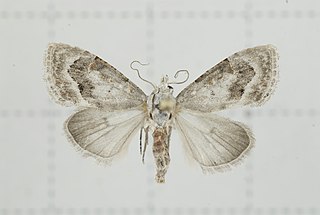
Naarda is a large genus of erebid moths currently encompassing 108 species. Initially identified by Francis Walker in 1866, it is in the family Erebidae. Somewhat ruddy in appearance, this genus is distinguishable for its generally slender thorax and abdomen, and straight, porrect labial palpi. Most species are a light tan color, but shading can reach as deep as a charcoal, with muddy yellow, conspicuous reniform, orbicular stigmata featured on the forewings, sometimes reflected bilaterally superior.

Comostola is a genus of moths in the family Geometridae erected by Edward Meyrick in 1888. They are found primarily in Asia and Australia.

Sauris is a genus of moths in the family Geometridae erected by Achille Guenée in 1857.

Symmacra is a monotypic moth genus in the family Geometridae described by Warren in 1896. Its only species, Symmacra solidaria, was first described by Achille Guenée in 1858. It is found in Indo-Australian tropics of India, Sri Lanka, Borneo east to Fiji, Samoa and Australia.

Adoxophyes fasciculana, the bell moth or orange tip moth, is a moth of the family Tortricidae. It was described by Francis Walker in 1866 from the Moluccas. It is also known from South Asia, Vietnam, Australia and the Pacific Islands. It is a polyphagous pest on several commercially important crops.

Epiplema is a genus of moths in the family Uraniidae described by Gottlieb August Wilhelm Herrich-Schäffer in 1855. A number of species have been reassigned to Europlema.

Hypena conscitalis is a moth of the family Erebidae first described by Francis Walker in 1866. It is found throughout Africa, from Senegal to South Africa, in South and South-East Asia as well as in Australia and on some Pacific and Indian Ocean islands.

Thumatha fuscescens is a moth of the family Erebidae first described by Francis Walker in 1866. It is found in Australia, South-East Asia, India, Sri Lanka, the Comoros, Réunion, Madagascar, and Gabon.
Tatobotys biannulalis is a moth in the family Crambidae. It was described by Francis Walker in 1866. It is found on Borneo and in Indonesia, the New Hebrides, Fiji, Samoa, Japan, Sri Lanka and Australia, where it has been recorded from the Northern Territory and Queensland.
Radara subcupralis is a moth of the family Noctuidae first described by Francis Walker in 1866.
Dysaethria conflictaria, or Epiplema conflictaria, is a moth of the family Uraniidae first described by Francis Walker in 1861. It is found in Indo-Australian tropics of India, Sri Lanka, Thailand, Papua New Guinea, the Solomon Islands and Australia.

Dysaethria fulvihamata is a moth of the family Uraniidae first described by George Hampson in. It is found in Sri Lanka, Taiwan, Hong Kong, the Ryukyu Islands and Borneo.
Epiplema irrorata is a moth of the family Uraniidae first described by Frederic Moore in 1887. It is found in India and Sri Lanka.
Britha biguttata is a moth of the family Erebidae first described by Francis Walker in 1866. It is found in India, Sri Lanka, Java, New Guinea, Bismarck Islands, Sulawesi, Java, Borneo, Myanmar, Taiwan and Australia.
Hypena varialis, is a moth of the family Erebidae first described by Francis Walker in 1866. It is found in India and Sri Lanka.
Pharambara micacealis is a moth of the family Thyrididae first described by Francis Walker in 1866. It is found in Sri Lanka, New Guinea and Australia.
Giaura tortricoides is a moth of the family Nolidae first described by Francis Walker in 1865. It is found in Sri Lanka, Japan, Andaman Islands, Borneo, Sumatra, Flores, Sulawesi, New Guinea, Bismarck Islands and Australia.
Labanda saturalis is a moth in the family Nolidae first described by Francis Walker in 1865. It is found in Indo-Australian tropics of India, Sri Lanka, and from New Guinea to the Solomon Islands.

Nola fasciata is a moth of the family Nolidae first described by Francis Walker in 1866. It is found in Indo-Australian tropics of India, Sri Lanka to Borneo, Taiwan, New Guinea and Australia.








